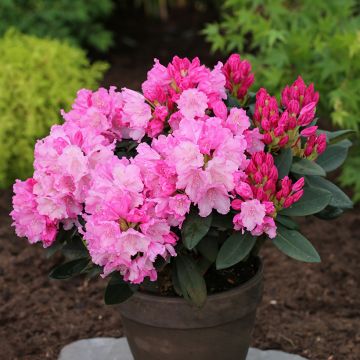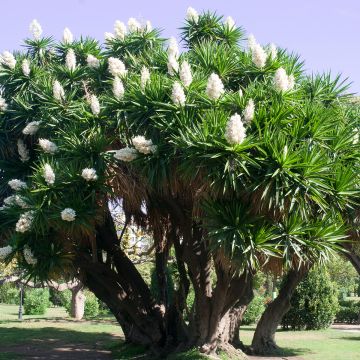

Pyracantha coccinea Saphyr Jaune - Scarlet Firethorn


Pyracantha coccinea Saphyr Jaune - Scarlet Firethorn
Pyracantha coccinea Saphyr Jaune - Scarlet Firethorn
Pyracantha coccinea SAPHYR Jaune® 'Cadaume'
Firethorn, Fire Thorn, Pyracanth, Pyracantha
Beautiful plant received at the same time as the orange Saphyr. No visible issues upon delivery. The Pyracantha appears to be in good health for now, and it seems that future flowering and fruiting should not be a problem.
Dany, 12/03/2024
Special offer!
Receive a €20 voucher for any order over €90 (excluding delivery costs, credit notes, and plastic-free options)!
1- Add your favorite plants to your cart.
2- Once you have reached €90, confirm your order (you can even choose the delivery date!).
3- As soon as your order is shipped, you will receive an email containing your voucher code, valid for 3 months (90 days).
Your voucher is unique and can only be used once, for any order with a minimum value of €20, excluding delivery costs.
Can be combined with other current offers, non-divisible and non-refundable.
Why not try an alternative variety in stock?
View all →This plant carries a 24 months recovery warranty
More information
We guarantee the quality of our plants for a full growing cycle, and will replace at our expense any plant that fails to recover under normal climatic and planting conditions.

Would this plant suit my garden?
Set up your Plantfit profile →
Description
The Pyracantha 'Saphyr Jaune®' is part of a line of bushes resistant to diseases such as bacterial fire blight and scab that affect older varieties. Both ornamental and incredibly robust, the 'Saphyr' developed by INRA have restored the reputation of these thorny bushes that have long been relegated to a defensive role and neglected. When left to grow freely, 'Saphyr Jaune' quickly develops a slightly untidy habit, with branches weighted down by bright yellow berries that blaze in the autumn light. Its branches arch with age, making it suitable for training. In spring, the white flowers attract many pollinating insects, while its berries provide food for birds in the colder months. An extremely easy bush to grow even in poor soils. Generously provided by nature, it deserves to be truly integrated into the garden's landscape!
Originally from Asia and southern Europe, pyracanthas have given rise to many horticultural varieties. Just like cotoneasters, they belong to the rose family. 'Saphyr Jaune', with vigorous growth, has a slightly pendulous bushy habit reaching 3 metres (9.8ft) in height with a spread of 2 to 3 metres (6.5 to 9.8ft). Its flowering period extends from May to July depending on the mildness of the climate. Numerous clusters of small pure white flowers appear along the branches, grouped in corymbs. These flowers are nectar-rich and pleasantly fragrant. Flowers are followed by bright berries, 1 centimetre (0.03in) wide, resembling yellow pearls. The small, shiny, dark green leaves, remain evergreen and dense in winter. The branches arch as they age, are tinged with red and equipped with formidable spines about 3 centimetres (0.09in) long.
Overused, overpruned, too diseased, and too common? The modern pyracantha is still a bush that tolerates any growing conditions and does not suffer from structural or artistic pruning. A boon for uncultivated or even rocky soils, it has the advantage of bringing a bit of lushness and colour to neglected gardens and abandoned boundaries, while perfectly fulfilling its role as a defender. Great for creating defensive hedges or topiaries, it will especially attract attention in autumn and winter with its abundant and colourful berries, while protecting the garden from prying eyes and sheltering many small, beneficial animals. It can be honoured by being allowed to grow freely, in the distance, at the corner of a neglected building, or at the edge of a natural grove; in these conditions, it will become covered with flowers or fruits. In a hedge, mix it with other varieties to play with the different colours of fruit, but also with other shrubs such as Cotoneaster, Holly, Eleagnus, Deciduous or Evergreen Spindle Trees, Brooms, Bay Laurel...
Report an error about the product description
Pyracantha coccinea Saphyr Jaune - Scarlet Firethorn in pictures


Plant habit
Flowering
Foliage
Botanical data
Pyracantha
coccinea
SAPHYR Jaune® 'Cadaume'
Rosaceae
Firethorn, Fire Thorn, Pyracanth, Pyracantha
Cultivar or hybrid
Other Pyracanthas
View all →Planting and care
'Saphyr Jaune' pyracantha is hardy and thrives in sunny or partially shaded positions, even in hot climates. Plant it in any well-prepared ordinary. It has no specific soil requirements and withstands summer drought once well established. Water regularly for the first two years, especially during hot and dry periods. This bush requires no other maintenance, except for pruning which, if necessary, should be light and done after flowering.
Planting period
Intended location
Care
-
, onOrder confirmed
Reply from on Promesse de fleurs
Similar products
Haven't found what you were looking for?
Hardiness is the lowest winter temperature a plant can endure without suffering serious damage or even dying. However, hardiness is affected by location (a sheltered area, such as a patio), protection (winter cover) and soil type (hardiness is improved by well-drained soil).

Photo Sharing Terms & Conditions
In order to encourage gardeners to interact and share their experiences, Promesse de fleurs offers various media enabling content to be uploaded onto its Site - in particular via the ‘Photo sharing’ module.
The User agrees to refrain from:
- Posting any content that is illegal, prejudicial, insulting, racist, inciteful to hatred, revisionist, contrary to public decency, that infringes on privacy or on the privacy rights of third parties, in particular the publicity rights of persons and goods, intellectual property rights, or the right to privacy.
- Submitting content on behalf of a third party;
- Impersonate the identity of a third party and/or publish any personal information about a third party;
In general, the User undertakes to refrain from any unethical behaviour.
All Content (in particular text, comments, files, images, photos, videos, creative works, etc.), which may be subject to property or intellectual property rights, image or other private rights, shall remain the property of the User, subject to the limited rights granted by the terms of the licence granted by Promesse de fleurs as stated below. Users are at liberty to publish or not to publish such Content on the Site, notably via the ‘Photo Sharing’ facility, and accept that this Content shall be made public and freely accessible, notably on the Internet.
Users further acknowledge, undertake to have ,and guarantee that they hold all necessary rights and permissions to publish such material on the Site, in particular with regard to the legislation in force pertaining to any privacy, property, intellectual property, image, or contractual rights, or rights of any other nature. By publishing such Content on the Site, Users acknowledge accepting full liability as publishers of the Content within the meaning of the law, and grant Promesse de fleurs, free of charge, an inclusive, worldwide licence for the said Content for the entire duration of its publication, including all reproduction, representation, up/downloading, displaying, performing, transmission, and storage rights.
Users also grant permission for their name to be linked to the Content and accept that this link may not always be made available.
By engaging in posting material, Users consent to their Content becoming automatically accessible on the Internet, in particular on other sites and/or blogs and/or web pages of the Promesse de fleurs site, including in particular social pages and the Promesse de fleurs catalogue.
Users may secure the removal of entrusted content free of charge by issuing a simple request via our contact form.
The flowering period indicated on our website applies to countries and regions located in USDA zone 8 (France, the United Kingdom, Ireland, the Netherlands, etc.)
It will vary according to where you live:
- In zones 9 to 10 (Italy, Spain, Greece, etc.), flowering will occur about 2 to 4 weeks earlier.
- In zones 6 to 7 (Germany, Poland, Slovenia, and lower mountainous regions), flowering will be delayed by 2 to 3 weeks.
- In zone 5 (Central Europe, Scandinavia), blooming will be delayed by 3 to 5 weeks.
In temperate climates, pruning of spring-flowering shrubs (forsythia, spireas, etc.) should be done just after flowering.
Pruning of summer-flowering shrubs (Indian Lilac, Perovskia, etc.) can be done in winter or spring.
In cold regions as well as with frost-sensitive plants, avoid pruning too early when severe frosts may still occur.
The planting period indicated on our website applies to countries and regions located in USDA zone 8 (France, United Kingdom, Ireland, Netherlands).
It will vary according to where you live:
- In Mediterranean zones (Marseille, Madrid, Milan, etc.), autumn and winter are the best planting periods.
- In continental zones (Strasbourg, Munich, Vienna, etc.), delay planting by 2 to 3 weeks in spring and bring it forward by 2 to 4 weeks in autumn.
- In mountainous regions (the Alps, Pyrenees, Carpathians, etc.), it is best to plant in late spring (May-June) or late summer (August-September).
The harvesting period indicated on our website applies to countries and regions in USDA zone 8 (France, England, Ireland, the Netherlands).
In colder areas (Scandinavia, Poland, Austria...) fruit and vegetable harvests are likely to be delayed by 3-4 weeks.
In warmer areas (Italy, Spain, Greece, etc.), harvesting will probably take place earlier, depending on weather conditions.
The sowing periods indicated on our website apply to countries and regions within USDA Zone 8 (France, UK, Ireland, Netherlands).
In colder areas (Scandinavia, Poland, Austria...), delay any outdoor sowing by 3-4 weeks, or sow under glass.
In warmer climes (Italy, Spain, Greece, etc.), bring outdoor sowing forward by a few weeks.




















































